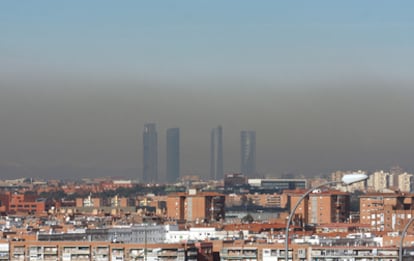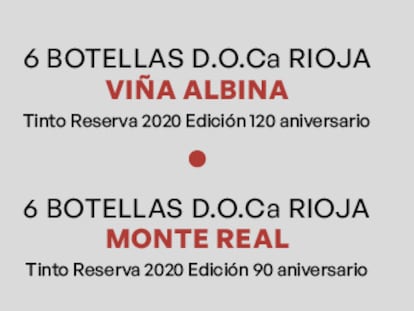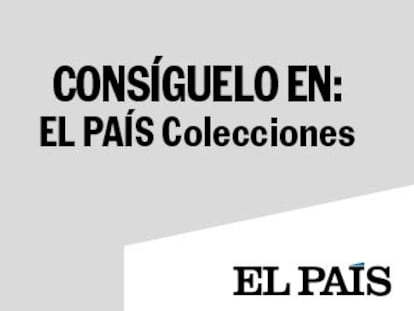Pollution row gets an airing ahead of mayoral elections in May
Socialists and Popular Party identify long-term plans to tackle Madrid smog
The fallout from Madrid's pollution war has been immediate. A day after Environment Minister Rosa Aguilar challenged the capital's City Hall to tackle Madrid's "dreadful air quality," serving Mayor Alberto Ruiz Gallardón presented the fruits of a three-year labor formulated by 50 experts in urban planning, architecture, economy and sociology, among others. The paper, Madrid Downtown Project, is not a plan per se, but a plan of ideas.
The proposed project covers the area built up during Madrid's urban boom in the 1950s, bordered by the M-30 beltway to the south, east and west and the axis of Silesio Delgado and Meteo Inurria streets to the north. A 51-square-kilometer total, it includes the neighborhoods of Salamanca, Retiro, Downtown, Chamberí, Chamartín, Arganzuela and part of Moncola-Aravaca.
Mayoral candidate Lissavetzky: "We don't need to take an inventory of the dust"
Among the ideas in the proposal?some bold, others faintly utopic?is a clear and inalienable push to limit traffic in the choked thoroughfares of the capital. This will entail "the specialization of some of the city's streets," said José María Ezquiaga, one of the project directors. "That is to say, demarcating some streets for traffic, and others for residents." In a nutshell, the idea is to concentrate traffic on the periphery of the city, and return central streets to the pedestrian.
It is an issue that will gather political capital in the run-up to municipal elections on May 22. Jaime Lissavetzky, the secretary of state for sport and Socialist candidate to the mayoralty, has promised to make pollution a priority if he is elected. His plan is much the same: limit traffic on days when the suspended-particle limits are usually exceeded, pedestrianization of the center, and dissuasive costs for parking. "We don't need to take an inventory of the dust," Lissavetzky said on Wednesday.
Incumbent Gallardón has also been busy: "We have begun a reflection so that we can adopt decisions today in the sphere of our responsibility," the Popular Party mayor said. "This paper represents the most important work of the next legislature; the definitive design of the city through a general plan. It's a task that begins today, but will never end."
NGO Ecologists in Action points to the "flagrant and constant" disregard for EU pollution limits, which Madrid has exceeded every year since 2000. In 2009 the discrepancy was 13 micrograms of NO2 per cubic meter above the legal limit. Last year this fell to an annual excess of four milligrams - largely because the City Hall moved many monitoring stations out of the center, and got rid of others entirely.

"The whole city's the same"
Luca de Tena is a square in downtown Madrid that passes almost unnoticed. Flanking six lanes of highways is an open, green space with a children's playpark. It doesn't appear on Google Maps. But while it may be discreet, it's also well known.
Luca de Tena has the dubious honor of being the most polluted spot in Madrid, according to Ecologists in Action's annual report. The residents remember the green box that for many years was in the middle of the square, under some trees, but is no longer there. It was a Madrid City Hall monitoring station. In 2009, it was the station that most often broke EU pollution limits. The continental benchmark is an annual average of 40 micrograms of NO2 per cubic meter. Luca de Tena registered 74.
"I like to open the window to let the air in," says Concha, the local pharmacist. "But it's full of dust again instantly. It's black: the paint, the curtains... It's from the cars of course." But Concha is not for moving. "I think the whole city's the same."
José, a shopkeeper, is worried about air quality, but shrugs. "What do you want me to say? The other day the girl from the news stand was mugged, and another girl from the fruit shop. There are more important problems."
Tu suscripción se está usando en otro dispositivo
¿Quieres añadir otro usuario a tu suscripción?
Si continúas leyendo en este dispositivo, no se podrá leer en el otro.
FlechaTu suscripción se está usando en otro dispositivo y solo puedes acceder a EL PAÍS desde un dispositivo a la vez.
Si quieres compartir tu cuenta, cambia tu suscripción a la modalidad Premium, así podrás añadir otro usuario. Cada uno accederá con su propia cuenta de email, lo que os permitirá personalizar vuestra experiencia en EL PAÍS.
¿Tienes una suscripción de empresa? Accede aquí para contratar más cuentas.
En el caso de no saber quién está usando tu cuenta, te recomendamos cambiar tu contraseña aquí.
Si decides continuar compartiendo tu cuenta, este mensaje se mostrará en tu dispositivo y en el de la otra persona que está usando tu cuenta de forma indefinida, afectando a tu experiencia de lectura. Puedes consultar aquí los términos y condiciones de la suscripción digital.
Últimas noticias
Lotería Nacional: sorteo del jueves 25 de diciembre
Respaldo del PP y críticas de la izquierda al discurso de Navidad del Rey
Tres de cada diez empleadas de hogar trabajan sin evaluación de riesgos por parte de sus empleadores
Feijóo entrega a la jueza los ‘whatsapps’ que recibió de Mazón el día de la dana
Lo más visto
- La revalorización de las pensiones queda en el aire por la negativa de la derecha a apoyar otras medidas sociales
- Juan Carlos Ferrero: “Más que dolor, siento pena; los finales siempre son tristes”
- El líder groenlandés responde a Trump: “Groenlandia es nuestro país. Nuestras decisiones se toman aquí”
- La cúpula de Vox votó por unanimidad la destitución de Javier Ortega Smith
- Los ‘whatsapps’ de Mazón a Feijóo del día de la dana: “Un puto desastre va a ser esto presi”




























































